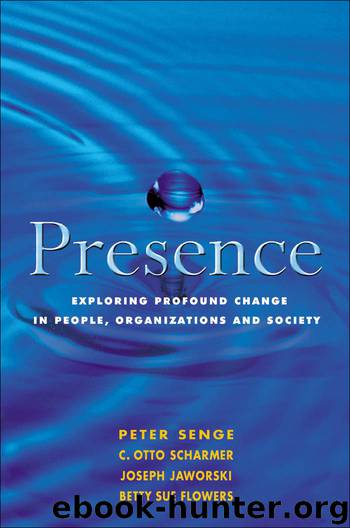Presence by Peter Senge

Author:Peter Senge [Senge, Peter]
Language: eng
Format: epub
Publisher: Nicholas Brealey Publishing
Published: 2005-05-22T12:00:00+00:00
Prototyping
A recurring theme in our interviews with entrepreneurs and innovators was the importance of fast-cycle experiments or rapid prototyping as a way of avoiding getting stuck in plans or trying to completely figure out “the true nature of the emerging whole.” Indeed, the true nature of an emerging whole can’t be accessed fully without engaging in concrete experiments, improvisation, and prototyping. What we begin to intuit starts to become clear and real for us in a totally new way once we consciously endeavor to make it manifest and stay open to the feedback that effort elicits. All the business and social activists that we talked to embodied this principle.
John Kao, a highly successful businessman, musician, and entrepreneur, founded the Idea Factory in San Francisco to help large companies achieve breakthrough innovations. For Kao, prototyping is at the heart of every creative design process. “Prototyping is modeling or simulating your best current understandings precisely so you can have a shared set of understandings that enable communication, especially among people with very different discipline bases. That allows you to break that prototype and iterate cycle until you get to some desired outcome, which you could not have predicted in the beginning.”2
For engineers, prototyping is a way of testing new design ideas embodied in physical (or computer-based) models. Prototyping in living social systems preserves the engineer’s commitment to testing, with two important differences. First, it is more open-ended and exploratory. As Kao says, in engineering “you start with a specification and then, if you do all the things that specification says, you get to the end point—usually by excluding all the other branches of the tree. But design enables you to travel down any branch that’s relevant to get to that end point.” Second, in living systems we ourselves are “the prototypes”! As Gandhi said, “We must be the change we seek to create.”
When shifting from visioning and crystallizing to prototyping, we reenter the sphere governed by the primacy of the concrete particulars. Prototyping is not about abstract ideas or plans but about entering a flow of improvisation and dialogue in which the particulars inspire the evolution of the whole and vice versa.
In its essence, prototyping accesses and aligns the wisdom of our head, heart, and hands by forcing us to act before we’ve figured everything out and created a plan. A tenet of prototyping is acting on a concept before that concept is complete or perfect. People concerned about success often want to slow down and plan or take more time to become comfortable with a course of action—but that may be exactly when you need to act. In Robert Redford’s movie Bagger Vance, Bagger tells his pupil, a gifted but unsure golfer, “Don’t think about it, feel it. The wisdom in your hands is greater than the wisdom of your head will ever be.”
Effective prototyping requires the capacity to stay connected and grounded in your deepest source of inspiration and larger will while simultaneously learning to listen to all of the feedback your actions elicit.
Download
This site does not store any files on its server. We only index and link to content provided by other sites. Please contact the content providers to delete copyright contents if any and email us, we'll remove relevant links or contents immediately.
Hit Refresh by Satya Nadella(9090)
The Compound Effect by Darren Hardy(8884)
Change Your Questions, Change Your Life by Marilee Adams(7696)
Nudge - Improving Decisions about Health, Wealth, and Happiness by Thaler Sunstein(7668)
The Black Swan by Nassim Nicholas Taleb(7068)
Deep Work by Cal Newport(6974)
Rich Dad Poor Dad by Robert T. Kiyosaki(6534)
Daring Greatly by Brene Brown(6479)
Principles: Life and Work by Ray Dalio(6307)
Playing to Win_ How Strategy Really Works by A.G. Lafley & Roger L. Martin(6109)
Man-made Catastrophes and Risk Information Concealment by Dmitry Chernov & Didier Sornette(5961)
Digital Minimalism by Cal Newport;(5716)
Big Magic: Creative Living Beyond Fear by Elizabeth Gilbert(5693)
The Myth of the Strong Leader by Archie Brown(5472)
The Slight Edge by Jeff Olson(5386)
Discipline Equals Freedom by Jocko Willink(5338)
The Motivation Myth by Jeff Haden(5181)
The Laws of Human Nature by Robert Greene(5095)
Stone's Rules by Roger Stone(5058)
